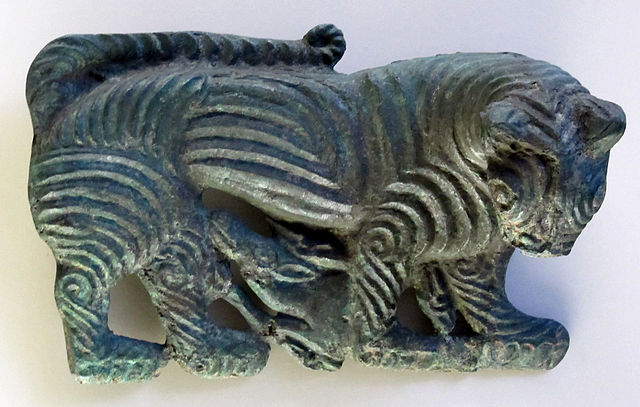The Ordos culture was a material culture occupying a region centered on the Ordos Loop during the Bronze and early Iron Age from c. 800 BCE to 150 BCE. The Ordos culture is known for significant finds of Scythian art and may represent the easternmost extension of Indo-European Eurasian nomads, such as the Saka, or may be linkable to Palaeo-Siberians or Yeniseians. Under the Qin and Han dynasties, the area came under the control of contemporaneous Chinese states.
Ordos culture
Bronze statuette of a man, Ordos, 3-1st century BCE. British Museum.
Belt plaque, with a tiger subduing an ibex, Ordos, 6-5th century BCE
Pazyryk tattoo design with zoomorphic symbols, 4th century BC. A precursor of the new Ordos designs.
The Ordos Plateau, also known as the Ordos Basin or simply the Ordos, is a highland sedimentary basin in parts of most Northern China with an elevation of 1,000–1,600 m (3,300–5,200 ft), and consisting mostly of land enclosed by the Ordos Loop, a large northerly rectangular bend of the Yellow River. It is China's second largest sedimentary basin with a total area of 370,000 km2 (140,000 sq mi), and includes territories from five provinces, namely Shaanxi, Gansu, Ningxia, Inner Mongolia and a thin fringe of Shanxi, but is demographically dominated by the former three, hence is also called the Shaan-Gan-Ning Basin. The basin is bounded in the east by the Lüliang Mountains, north by the Yin Mountains, west by the Helan Mountains, and south by the Huanglong Mountains, Meridian Ridge and Liupan Mountains.
Approximate area of Chinese civilization during the Spring and Autumn period. Note the extension up the Wei valley
Bronze statuette of a man, Ordos, 3-1st century BC. British Museum. Otto J. Maenchen-Helfen notes that the statuette displays clear Europoid features.





